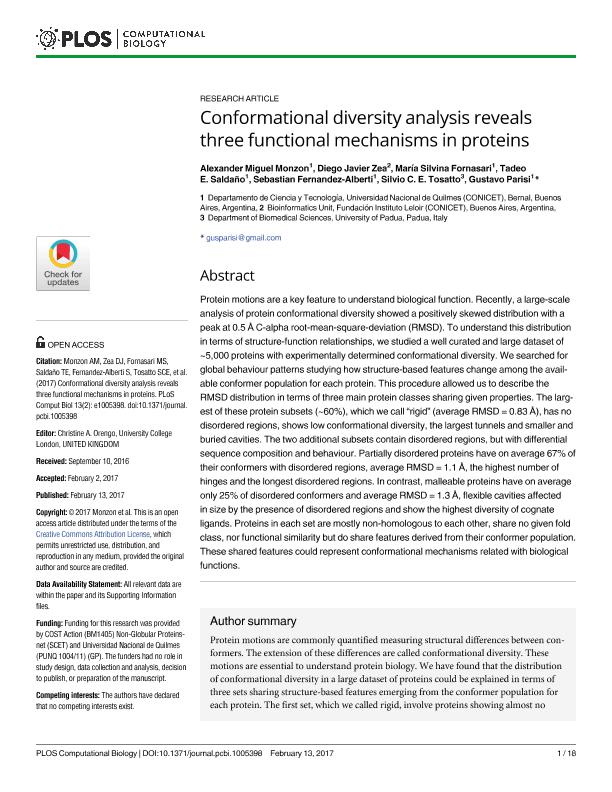Artículo
Conformational diversity analysis reveals three functional mechanisms in proteins
Monzón, Alexander ; Zea, Diego Javier
; Zea, Diego Javier ; Fornasari, Maria Silvina
; Fornasari, Maria Silvina ; Saldaño, Tadeo Enrique
; Saldaño, Tadeo Enrique ; Fernández Alberti, Sebastián
; Fernández Alberti, Sebastián ; Tosatto, Silvio C. E.; Parisi, Gustavo Daniel
; Tosatto, Silvio C. E.; Parisi, Gustavo Daniel
 ; Zea, Diego Javier
; Zea, Diego Javier ; Fornasari, Maria Silvina
; Fornasari, Maria Silvina ; Saldaño, Tadeo Enrique
; Saldaño, Tadeo Enrique ; Fernández Alberti, Sebastián
; Fernández Alberti, Sebastián ; Tosatto, Silvio C. E.; Parisi, Gustavo Daniel
; Tosatto, Silvio C. E.; Parisi, Gustavo Daniel
Fecha de publicación:
02/2017
Editorial:
Public Library of Science
Revista:
Plos Computational Biology
ISSN:
1553-734X
e-ISSN:
1553-7358
Idioma:
Inglés
Tipo de recurso:
Artículo publicado
Clasificación temática:
Resumen
Protein motions are a key feature to understand biological function. Recently, a large-scale analysis of protein conformational diversity showed a positively skewed distribution with a peak at 0.5 Å C-alpha root-mean-square-deviation (RMSD). To understand this distribution in terms of structure-function relationships, we studied a well curated and large dataset of ~5,000 proteins with experimentally determined conformational diversity. We searched for global behaviour patterns studying how structure-based features change among the available conformer population for each protein. This procedure allowed us to describe the RMSD distribution in terms of three main protein classes sharing given properties. The largest of these protein subsets (~60%), which we call "rigid" (average RMSD = 0.83 Å), has no disordered regions, shows low conformational diversity, the largest tunnels and smaller and buried cavities. The two additional subsets contain disordered regions, but with differential sequence composition and behaviour. Partially disordered proteins have on average 67% of their conformers with disordered regions, average RMSD = 1.1 Å, the highest number of hinges and the longest disordered regions. In contrast, malleable proteins have on average only 25% of disordered conformers and average RMSD = 1.3 Å, flexible cavities affected in size by the presence of disordered regions and show the highest diversity of cognate ligands. Proteins in each set are mostly non-homologous to each other, share no given fold class, nor functional similarity but do share features derived from their conformer population. These shared features could represent conformational mechanisms related with biological functions.
Palabras clave:
Protein Evolution
Archivos asociados
Licencia
Identificadores
Colecciones
Articulos(IIBBA)
Articulos de INST.DE INVEST.BIOQUIMICAS DE BS.AS(I)
Articulos de INST.DE INVEST.BIOQUIMICAS DE BS.AS(I)
Articulos(SEDE CENTRAL)
Articulos de SEDE CENTRAL
Articulos de SEDE CENTRAL
Citación
Monzón, Alexander; Zea, Diego Javier; Fornasari, Maria Silvina; Saldaño, Tadeo Enrique; Fernández Alberti, Sebastián; et al.; Conformational diversity analysis reveals three functional mechanisms in proteins; Public Library of Science; Plos Computational Biology; 13; 2; 2-2017; 1-18; e1005398
Compartir
Altmétricas



